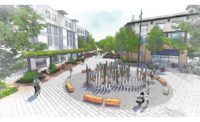What’s in a name? In the case of Los Angeles-based CO Architects, the essence of its practice. Rather than an abbreviation, “CO” serves as a prefix meaning “jointly, equally and together with”—attributes that have made the firm something of an institution in the realm of institutional design.
“You could say ‘CO’ also stands for collaboration, cohesion and commitment,” says Scott Kelsey, the firm’s managing principal. The result is relationships with higher education, health care, civic and research-oriented clients—some spanning decades—that support complex programs and allow for manipulating forms and materials to striking, eye-catching effect. Examples include the futuristic Student Services Building for Pomona, Calif.-based California State Polytechnic University and the modular, metal-clad Koman Family Outpatient Pavilion for the University of California-San Diego (UCSD), completed in 2018. No two of the firm’s projects appear even remotely the same.
“Each project is about the client, its setting, its geographic location and what’s going on inside the facility,” Kelsey says.
Concepts such as collaboration and cohesion likewise extend to relationships within the 33-year-old firm, formerly a regional office with now-defunct architect Anshen + Allen. Although its projects blanket 27 states, the 110-employee firm continues to maintain a single office in Los Angeles.
“Our philosophy is to consolidate under a single roof where colleagues can work together, compare ideas and learn from each other,” Kelsey says. “In some respects, our work follows a continuum. Hospital design, for instance, influences the manner in which medical schools are designed, so that students are better prepared to practice as physicians.”
“Our philosophy is to consolidate under a single roof where colleagues can work together, compare ideas and learn from each other.”
– Scott Kelsey, Managing Principal, CO Architects
“From time to time we discussed opening regional offices, but ultimately felt we could wind up diluting our culture, which can occur as a result of expansion or acquisition,” adds CO principal and marketing director Jill Capanna. “We’re satisfied with the cross-pollination we’ve achieved among staff members engaged in related facilities such as medical schools, health care centers and R&D labs.”
Rather than confine designers to a single building type, “We engage them in all types under the leadership of firm principals,” says Kelsey. “We want our staff members to be generalists.”
It’s a winning formula. The firm’s revenue in California alone rose 25% in 2018 to $25.64 million. Commissions within California account for about 70% of its workload, which also includes strategic planning and interiors work.
Several projects have emerged as instant icons, including the $79-million, 138,450-sq-ft Student Services Building for California State Polytechnic University. Serving as gateway to the school, the three-story facility is capped by undulating white aluminum terminated by perforated overhangs that shade exterior glass, reduce thermal loads and maximize desired daylighting. “In some respects, the design is inspired by surrounding hills and mountains,” says Kelsey. More pragmatically, the configuration contributes to a sustainable design program built to LEED Platinum standards.
In all, more than a quarter of the firm’s work involves sustainable design “because many institutional clients, including universities,” require it these days, Kelsey observes. The Student Services Building also includes 7,560 LED lights, low-emission glass windows and locally sourced materials, among other sustainable features.
For UCSD’s $140-million, 156,000-sq-ft Koman Family Outpatient Pavilion—a LEED Gold facility—CO Architects accommodated disease centers for musculoskeletal health, breast health, urology, pain, apheresis and stem cells, enclosing east and west facades in a rainscreen consisting of corrugated aluminum panels and strategically punched openings to minimize heat gain and glare. In this instance, the skin’s texture emulates patterns of the coastal La Jolla bluffs in Southern California. Colors and materials are consistent with those of existing campus buildings.
“There’s no arguing CO Architects is a world-class firm,” says Mark Rowland, an architect and program manager with UCSD’s capital program management group. “It’s been involved in one project or another on campus during my entire tenure with UCSD, since 2003. There’s a sense of continuity with them—I’m working with some of the same firm designers I did years ago.”
Projects such as the Skaggs School of Pharmacy, one of the first projects CO designed upon Rowland’s arrival on campus, “proved they were very competent indeed,” he says.
The firm has developed 30-year relationships with health care provider Kaiser Permanente and University of California at Los Angeles (UCLA), according to Kelsey.
‘Super-Fascinated by Technology’
The best projects come from the best collaborations, says Kelsey. Key to collaborations among project team members is extensive use of technologies ranging from building information modeling (BIM) to virtual and augmented reality to computational design.
“As a firm, we are super-fascinated by digital technology,” says Kelsey.
As a result, “Clients know what they’re getting,” says Rowland. “It’s not simply that the firm has all the gadgets, but that it knows how to use them. It’s one of the reasons they keep coming back.”
CO Architects was an early adopter of BIM. The firm cut its teeth on the technology in 2004 as beta testers for the Autodesk platform Revit—and did so in a big way by selecting to apply the software to its largest project, the 740,000-sq-ft Palomar Medical Center in Escondido, Calif.
“At the time, it was one the largest projects to incorporate BIM,” recalls Jennifer Knudsen, a CO principal and an early champion of the technology who first joined the firm in 1998, then rejoined it in 2004. In all, CO has collected three awards for its work with BIM from the American Institute of Architects, which characterized the firm as “pioneers who blazed the trail for the rest of the industry.”
Among other benefits, “BIM has allowed us to become more cost effective,” says Knudsen. “We can detect clashes and costs early, gain a quicker understanding of a design component and its constructibility, reduce rework and ensure an unwanted component isn’t included in the design after the building is constructed.”
As a complement, virtual and augmented reality provide clients and other project team members with a much clearer idea of how a building will look and function before it is built,” says Knudsen, who notes that 360-degree views are much easier to develop among designers working with Revit. “By virtue of headsets or other apparatuses, you can walk through an entire space,” adds Kelsey.
Computational design quickly generates component options and variations based on such information as size and square footage.“It may generate, say, the three best options for an exterior metal panel,” says Kelsey. The firm has implemented computational design for a number of activities involving conceptual massing and master planning, complex geometry development, fabrication-level detail development, simulation of daylighting and profiling.
“We’re definitely out there in terms of exploring as much data as we can relating to building performance, building program, internal spaces and the technologies of a building” says Kelsey. “It ultimately leads to better collaborations among team members, from client, to contractor to engineer to subcontractor.”







Post a comment to this article
Report Abusive Comment